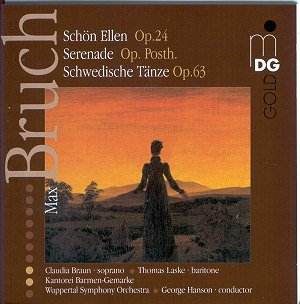Without wishing to sound patronising, the standards
of German orchestras from the so-called B list of opera houses and towns
are remarkably good. I myself conducted one such orchestra last year,
coincidentally in a festival concert of Bruchís music (well not really
much of a coincidence for I am his only biographer, a source
recognisably plundered by the booklet writer of this CD with regrettably
no due acknowledgement) and I did some of the Swedish Dances to
start the programme, as this disc does. Bruch never meant them to be
played all at one sitting, but one cannot blame a company for recording
all sixteen, even in their original format for solo piano. Hansonís
tempi are sometimes too fast, other times too slow, but his orchestra
sounds fine, especially the woodwinds. Bruch loved the cor anglais and
the player here would surely have pleased him. Hanson does not sentimentalise
the rich melodies but paces and phrases with care yet without losing
forward drive, especially the 13th with its divine solo for
the leader of the orchestra (succulently sweet here). The Dvorak/Brahms
flavour of some of the dances is especially well caught.
The Serenade for Strings is a reworking of a
rather overblown orchestral suite written a dozen years before in 1904,
but though the old man was in his late seventies, isolated and devastated
by the effects of the First World War, he had not his touch in scoring
for orchestra. Itís somewhat of a misnomer for the title here has omitted
the crucial words Ďon Swedish melodiesí and itís just that element of
folk music which so attracted Bruch throughout his life, and itís also
misleading of the booklet writer even to mention the possibility of
any programmatic content, even though she alludes to my assumption that
they were posthumous additions by the unscrupulous publisher Rudolf
Eichmann. It was more than an assumption; it was a fact. Bruchís music
has no need of titles, and this is a work which takes a place besides
Griegís Holberg Suite or Dag Wirénís Serenade.
Hansonís string section does it justice, nicely shaded playing, delicate
or rough-edged tone where required, wide-ranging dynamic contrasts;
in short they give a performance which captures the essence of Bruchís
style through and through, apart from one overdone portamento
in the fourth movement Andante sostenuto. The finale is beautifully
delicate, especially the very end of the work.
Another misnomer on this disc is its subtitle ĎOrchestral
Worksí, for Schön Ellen Op.24 is a choral ballad, for two
solo singers, chorus and orchestra. Here too we are in the realm of
folk music, in this case Scotland for which Bruch held a life-long affinity,
though I can find no evidence that he ever went there. Even so the Scottish
link is tenuous. Set at the Siege of Lucknow in India in 1857 it relates
how Ellen predicts its relief by the regiment led by the Campbells but
her foresight is only because she has acute hearing and can hear the
regimental marching song before anyone else does. The Campbells are
coming therefore features throughout. How one can sing or conduct
this work with a straight face is hard these days, though it helps if
you sing it in German and avoid overdoing the rum-ti-tum nature of its
6/8 rhythm. Claudia Braun pronounces it ĎKembellsí so that helps, while
Sir Edward is rechristened Sir Edvard by the male members of the chorus.
Thomas Laske copes well with the high tessitura of the baritone line,
a feature developed in Bruchís later secular oratorios with Heldenbaritones
in title roles such as Odysseus or Moses. Thereís no other way to present
this style (itís a couple of years to go before the first violin concerto
of 1867) other than the way it was meant and all here, soloists, chorus,
orchestra and conductor, do just that especially at its jubilant ending.
Christopher Fifield


